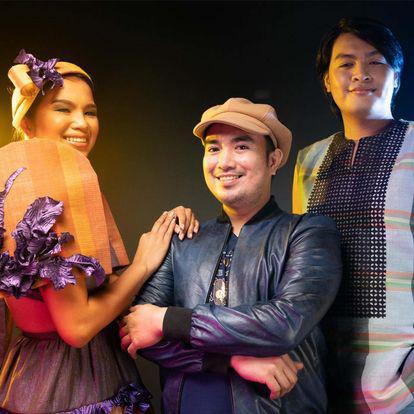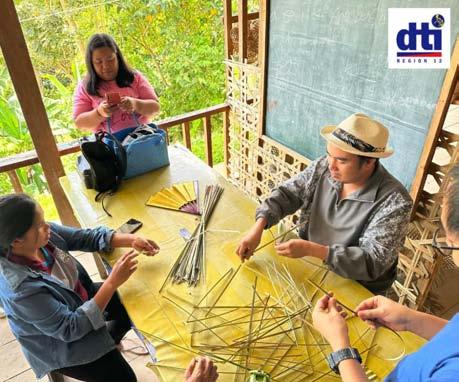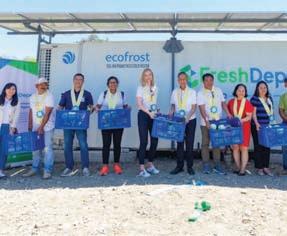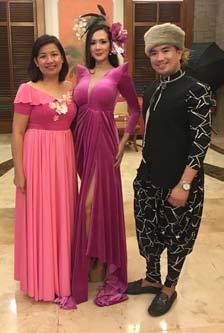
5 minute read
Famous couturier ventures into handicraft designs
HIGH fashion designer Ivan Raborar of Ivan Raborar Couture expanded his brand of artistry to interior and handicraft designing.
Collaborating with the government is a new thing for the 39-year-old designer. The Department of Tourism was the first to notice that his talent is not limited to creating beautiful gowns and wearables. He was tapped by the agency to redecorate its regional office in Koronadal City.
“That was a surprise. I never thought I would be seen in a different light. But I took the offer as a challenge, not only to test my limits, but also to expand my boundaries as an artist. I believe we can still grow and develop new capacities no matter what age we are and how far we have journeyed in our careers. There’s so much I still want to discover for myself and with myself,” he said.
“They [DOT] have given me a big task—to create iconic pieces showing the Mindanaoan culture. I have never before created useful things except for clothes and fashion accents. Going beyond what I usually do is kind of exciting because you get to meet normal people who depend on you and look up to you as a mentor,” he added, referring to a group of handicraft women he met through the Department of Trade and Industry.
In his search for suppliers, Raborar bumped into the DTI looking for materials for the first few handicrafts he intended to use to adorn the receiving area of the DOT regional office. This marked the start of another engagement with a government office, this time creating a lasting heritage of designs and helping the women of Lake Sebu, through the intervention of DTI Region 12, innovate and keep abreast of local and global trends.
Raborar intends to create a chandelier made of woven bamboo in the shape of small tuna-like fishes, one of the iconic pieces he has initially set to create with the Kestubong Women’s Association Agrarian Reform Beneficiaries (KeWARB)—a group of amazing women handicraft weavers based in Lake Sebu.

The engagement with the DTI involves a marketing partnership agreement with KeWARB, forged under the DTI Comprehensive Agrarian handicraft designs to everyday details seen in South Cotabato—things that are taken for granted but are part of and dominate the daily scene in the streets, at home and other familiar places from where he grew up.
He started redesigning KeWARB’s lampshades with a fresh look, incorporating daily facets of life in the otherwise humdrum and age-old blueprint the group has been repeatedly doing for ages.
Fresh Depot opens cold storage unit in the north
FOLLOWING the successful introduction of its first pilot cold storage unit in Benguet, Aboitiz Group’s Fresh Depot has launched its second pilot unit in Nueva Vizcaya Agricultural Terminal (NVAT), one of the country’s biggest trading centers located in the Cagayan Valley region.
Aboitiz Equity Ventures chief transformation officer Emilie Sydney-Smith said Fresh Depot continues to contribute to the country’s food sustainability by providing a physical and digital platform for farmers, with cold storage as its springboard.

“Filipino farmers face so many challenges, it can be hard to know where to start. When we saw that cold storage technology could prevent around half of their crops from spoiling between harvest and consumption, this was an obvious answer. Getting paid for most, not half, of their production means that farmers will soon be able to invest in other products that can create a virtuous cycle in their prosperity. Digitally tracking the cold storage usage means we can also help the government understand how they can better support farmers,” she said.
With Fresh Depot’s innovative pilot unit, farmers and traders can now efficiently store their surplus produce and preserve its freshness until it reaches the market. This groundbreaking solution aims to significantly reduce food wastage and enhance the food supply chain in the Philippines.
Moreover, Fresh Depot seeks to provide value-adding services, such as establishing a comprehensive database that the government can leverage to enhance their agricultural initiatives.
Reform Program where Raborar will be providing KeWARB with exclusive product designs for mass production. He will buy the finished products at fair market price, and these products will be incorporated in his couture and creative works.


The renowned local couturier and creative design consultant of the province has many affiliations that can get him to supply a string of local hotels in South Cotabato, as he also seeks to expand his footprint to the rest of the country. Export is an ambitious goal he plans for the long term.

Raborar intends to focus his
Product designing was an alien concept to Rabonar until KeWARB. It has taken a whole new experience on how the designer sees artistry and aesthetics in everyday living. This coming July, Rabonar plans to join the T’nalak Festival to showcase the collaborative pieces he created with the amazing skills of KeWARB weavers.
“I am raring for the public launch of this collaboration with KeWARB and the DTI. In the upcoming T’nalak Festival we will show how Lake Cebu handicraft weavers have innovated as they have now the means to transform native handicrafts into modern utilitarian pieces but keeping attuned to the cultural ethnicity of Mindanaoan art,” he said. His work will also benefit a host of indigenous women who are members of KeWARB. Raborar said the indigenous people have a special spot in his heart as they are the weavers of native fabrics he used for his couture collection. He uses indigenous fabrics like T’nalak, T’boli, Maguindanaoan and B’laan textiles, and does the bead working and ethnic embroideries as well.
Raborar has been designing clothes since he was in high school. For somebody who has not had any formal education in sewing clothes, Ragonar considered his talent innate. His exposure to the craft began at an early age. His father was a known seamster in their municipality in Koronadal, South Cotabato and his mother was an equally competent seamstress. Everyone else in his family knows how to sew but it was only him who seriously considered sewing as a profession, making use of the talent that was passed on
Global brands launch ready-to-drink cocktail
JACK DANIEL’S & Coca-Cola introduced an alcoholic ready-todrink (aRTD) premium cocktail in the Philippines, inspired by one of the world’s most popular branded “bar calls”, in a convenient, readyto-drink format.
“While Jack Daniel’s and Coca-Cola have long been mixed at home and in bars around the world, today we’re officially introducing to the Philippines a premium drink that unites two iconic brands in a ready-to-drink cocktail blend with so many perks, including its can,” said Coca-Cola ASEAN and South Pacific East Region frontline marketing director Cesar Gangoso.
Made with Jack Daniel’s Tennessee Whiskey and Coca-Cola, the aRTD is currently hitting the shelves in the Philippines. The can and packaging, which feature two of the world’s most recognizable and valuable trademarks in “Coca-Cola” and “Jack Daniel’s”, will include clear responsibility symbols stating that the beverage is to be enjoyed responsibly and only by consumers of legal drinking age.
“We are excited that Jack Daniel’s and Coca-Cola ready-todrink cocktail is expanding to new markets, including the Philippines, allowing more fans of the classic cocktail to enjoy the taste that set the standard for bar calls around the world,” said Emerging Asia Brown-Forman general manager Sally Goh.

All marketing of the Jack Daniel’s and Coca-Cola aRTD product will adhere to alcohol-responsible marketing policies and practices held by Brown-Forman and The Coca-Cola Company. Jack Daniel’s and Coca-Cola is available in 320 ml slim cans with an alcohol content of 7 percent.






